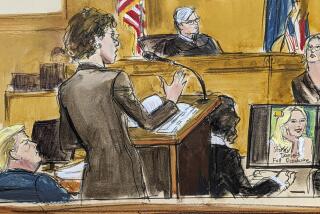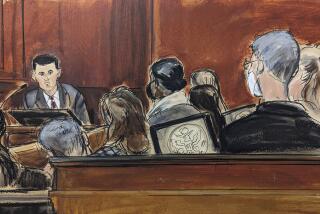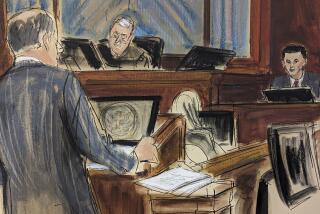Sentenced to Service, Foreman Says Trial Cost Jurors Too
- Share via
MIAMI — Halfway through the historic two-year trial of Big Tobacco, jury foreman L. Anthony Finegan wanted to quit.
Frustrated by the slow-motion pace of the high-profile case, under family pressures at home and seeing his career as a high school administrator crumbling, Finegan said he went to Judge Robert P. Kaye and asked for help.
But, said the 44-year-old native of Jamaica, satisfaction was hard to find. “He made a call to my boss, but I don’t think he understood,” Finegan said Friday evening in an interview with The Times in his comfortable suburban home south of Miami.
Finegan offered sharp criticism of the way the case was handled, especially by lawyers for the tobacco companies, but he was most concerned with the effects of what he called an ordeal on his personal and professional life.
“At work I was becoming more and more marginalized. Eventually they took my office away and packed up my stuff.
“My boss said everything would be OK. But the reality was, the case was more important. To the court we were numbers.”
Indeed, the case was important, the first class-action smokers’ lawsuit ever to come to trial. The $144.8-billion judgment handed down by Finegan and five other jurors could stand as the most costly decision ever rendered in a U.S. court.
But the trial cost Finegan and the other jurors too.
When the 12 men and women--six jurors and six alternates--were impaneled July 7, 1998, Finegan said they were told that the case would be over in three to four months.
But as the case dragged on, he said, “I felt like I had been sentenced. It took a tremendous toll.”
Although Finegan and the other jurors were able to report to work as normal on some days when court was not in session, they missed months of work. The other jurors were a welder, bank teller, school custodian, post office employee and phone company technician.
Eventually, Finegan requested a transfer from the high school to a less-prestigious post as assistant principal at an elementary school. Although he was able to draw his regular salary, he was unable to work during the summer for extra money. He, his schoolteacher wife and their son have not been on a vacation for two years.
Other stresses, he said, stemmed from the “repetitive, insulting” nature of the arguments from both sides, Finegan said. “The defense insulted our intelligence in the way they presented the evidence. For example, the way they promoted their Web site where they [report scientific findings that] smoking is dangerous. But they never said, ‘We agree with that.’ ”
Often, Finegan felt that tobacco company chief executives who testified were “playing to us, to the jury’s mind, in a way that was not truthful, not straight.”
For example, he said, Nicholas Brookes, chairman of Brown & Williamson Tobacco Corp., “came across as someone trying to reach out to sick smokers, to apologize, but then he would say that he never saw any evidence of misconduct. That bothered me.”
Finegan also said R.J. Reynolds Tobacco Co. chief Andrew Schindler “talked to us the wrong way. He was not ready to acknowledge mistakes, not ready to apologize.”
Of Philip Morris lawyer Dan Webb, who handled the bulk of the courtroom load for the defendants, Finegan said: “He seemed to me like a legal shark, skilled, a superb technician. But he didn’t come across as having strong humanistic qualities, and so he wasn’t likable.”
Nonetheless, Finegan said, neither he nor the other jurors wanted to punish individuals. They had earlier issued two verdicts, finding Big Tobacco liable for deceiving the public about the addictive, harmful nature of smoking and then found them responsible for the health problems of three sick smokers who represent the class.
“We wanted to send a strong message consistent with our two other verdicts,” he said.
Relying on figures introduced by financial experts presented by plaintiffs’ attorney Stanley Rosenblatt, each juror suggested a ballpark award, Finegan said. Those figures ranged from $100 billion to $200 billion. The average was $145 billion. From there, Finegan said, the jurors parceled out the damages according to market share.
He said the jurors distrusted the figures of corporate worth offered by Big Tobacco. “We realized that if the companies wanted to give us the values, why didn’t they bring in their chief financial officers? That disturbed us. We didn’t get the real story.”
Over the months of testimony, Finegan grew to appreciate Rosenblatt, an Orthodox Jew who Finegan said came across like “a Baptist preacher.”
“He was powerful, convincing and persuasive,” he said. “And when I looked at the documentation and the evidence, I came to respect him more for what he said.”
After the jury’s verdict was read, Kaye commended each juror for serving. “You gave up your jobs, your travels, your everyday existence for two years,” the judge said. The jurors then were presented with a certificate of service and a paperweight embossed with the court seal.
Over time, Finegan said, the jurors became very close. They argued over the first two verdicts, then they came to counsel each other, sharing feelings. “We had an excellent rapport; we were able to give each other support.” They already are discussing an annual reunion, he said.
“We were aware that we were making history,” said Finegan, a burly, soft-spoken nonsmoker with a shaved head and a goatee.
“We were all convinced that we did what we had to do. But we’ve all paid a huge price.”
*
Times researcher Anna M. Virtue contributed to this story.
More to Read
Sign up for Essential California
The most important California stories and recommendations in your inbox every morning.
You may occasionally receive promotional content from the Los Angeles Times.










